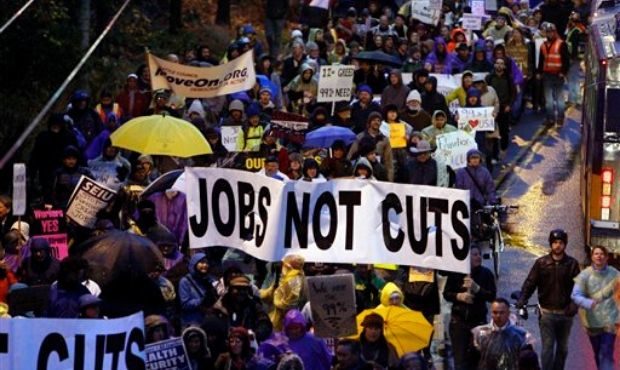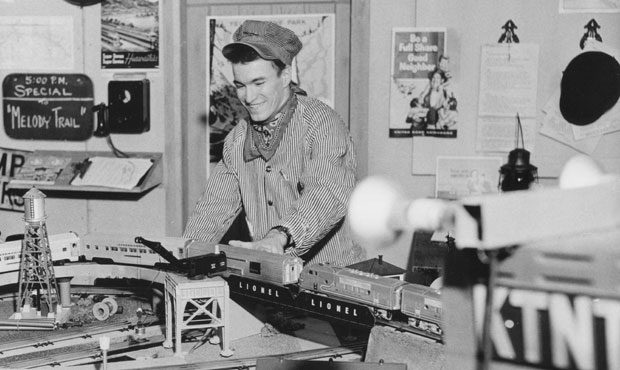Long history of racial and economic unrest in Seattle
Jun 4, 2020, 3:26 PM | Updated: Jun 5, 2020, 1:03 pm

A march by Occupy Seattle protesters traveled through Seattle streets, stopping briefly at the University Bridge near the University of Washington in Seattle, on Thursday, Nov. 17, 2011. (AP Photo/Kevin P. Casey)
(AP Photo/Kevin P. Casey)
The history of Seattle and the post-settlement era of the Pacific Northwest is rife with violent episodes rooted in conflicts over race, economics and often both.
Some notable events in this non-comprehensive list include:
The Treaty War of 1855-1856
You could argue that the first violent episode in the city’s history was the Treaty War of 1855 and 1856. It was late January 1856 when the city was under siege for most of a day, with settlers in blockhouses, and Indians “thronging the woods” – as one contemporary observer later wrote — around what was then a pretty tiny settlement of Seattle.
The cause wasn’t too complex. The Native Americans were understandably angry about the influx of settlers and about the treaty negotiations overseen by that complex figure we often mention in these KIRO Radio and MyNorthwest history stories: Isaac Stevens. Native Americans stood in the way of American-style governance and American-style real estate ownership, and many settlers hoped they would ultimately die off and get out of the way.
Two settlers died of gunshots in the conflict in Seattle that January day. It’s unclear how many Native Americans might have died. And there wasn’t a police department, but there were volunteer militia members. Also, one decisive factor: the U.S. Navy was offshore firing deck guns from the Sloop-of-War Decatur, and US Marines were onshore firing a howitzer into the woods.
Anti-Chinese Riots of 1885-1886
Fast-forward about 30 years to the fall of 1885, and you have the beginnings of what would become the Anti-Chinese Riots. Racially and economically motivated Washington Territory residents saw Chinese men, many of whom had worked building the railroad, as a threat.
A new federal law, passed in 1882, legally excluded most Chinese from entering the United States.
In Rock Springs, Wyoming Territory on September 2, 1885, 28 Chinese miners were killed by a mob of whites. It’s not clear if the Wyoming incident played any direct role to incite violence in Washington Territory, but soon after, on September 7, 1885, three Chinese hops pickers were killed by a mob in what’s now Issaquah. Four days after that, a group of Chinese mine workers were attacked and driven out of what’s now Newcastle.
In November 1885, about 200 Chinese residents of Tacoma were violently removed from their homes and marched to the railroad station and forced onto trains that took them south to Oregon. Then, similar incidents took place in Olympia, Bellingham, and several other places.
Governor Watson Squire asked for federal help, and President Grover Cleveland sent troops from Fort Vancouver to Seattle, where they stayed for about a week until the trouble passed.
Then, early on the morning of Sunday, February 7, 1886, a mob of 1,500 white men forced 300 Chinese residents from their homes in Seattle’s “Chinese Quarter,” which in those days was centered around Third Avenue and Washington Street. The Chinese were marched or driven in horse-drawn wagons, with their belongings, to the public pier at the foot of Washington Street and onto a ship.
Sheriff John McGraw interrupted the forced departure and a court proceeding took place. When that was over, the ship departed on Monday with about 200 Chinese aboard. The hundred or so remaining were allowed to head back toward their homes in the Chinese Quarter to wait for the next ship, the mob rose up and tried to divert the Chinese to the railroad station. A violent confrontation broke out in the intersection of what’s now First Avenue and Main Street, and one of Sheriff McGraw’s volunteers shot and mortally wounded one of the rioters. Two other rioters were also wounded by gunshots.
Late 19th and Early 20th Century Labor Unrest
For the next several decades, the unrest around here was mostly economic, because relatively speaking, there were very few people of color. There were national events such as the financial “Panic of 1893” that led to banks failing and to widespread unemployment, which in turn spawned national movements that resonated in the Northwest, such as Coxey’s Army. And there were struggles between labor and management, have and have not—and the emergence of labor groups like the International Workers of the World, known as the IWW or the Wobblies.
From the 1890s up to the early 1920s, there were a number of riots and violent confrontations all over the Pacific Northwest.
May Day 1912
On May 1, 1912, there was a May Day parade downtown. As part of that parade, Wobblies and Socialists marched up Second Avenue carrying a red flag. Outside the Mission Bar 1322 Second Avenue, Major Cal Welbon from the Washington National Guard grabbed the red flag and ran away with it. IWW members chased after Major Welbon, who ducked into the Mission Bar.
Veterans, police officers and others blocked the IWW members from entering the bar, so the IWW members went after a nearby American flag. There was a scuffle, and the flag was damaged. A deputy drew his revolver and told the men to “Get off that flag.” The IWW marchers continued uptown to their headquarters, were demonstrations and speeches went on long into the night. The unrest continued for several day, with newspapers handing out free US flags, and Spanish American War vets –the volunteers for whom “Volunteer Park” had been named—were patrolling the city to prevent “sedition.”
Other violence of this era includes the Potlatch Riot in Seattle on July 18, 1913, with more clashes between IWW members and military veterans; the Everett Massacre of November 5, 1916, with at least five dead and nearly 30 wounded in a gun battle between IWW members and law enforcement in Snohomish County; and the Centralia Massacre of November 11, 1919, with five victims, including four legionnaires and one member of the IWW.
The decades of labor unrest culminated in February 1919 with the Seattle General Strike, which shut down the city for several days, but which was a relatively peaceful event. A decade later, during the Great Depression of the 1930s, protests and demonstrations were common, such as so-called “Hunger Marches” to the state capitol, lead by Seattle’s Unemployed Citizens’ League.
Pearl Harbor Blackout Riot, December 8, 1941
You can’t really point to race or economics as the fuel behind Seattle’s Pearl Harbor Blackout Riot of December 1941 on the day after Pearl Harbor was attacked.
The property destruction began on Monday, December 8, just after 11 p.m., when a crowd, in a mood of “patriotic ardor,” according to the Seattle Post-Intelligencer, heaved rocks and cans at the neon sign of the Foreman and Clark clothing store at Fourth Avenue and Pike Street. The blackout was intended to prevent the Japanese from targeting Seattle with an aerial attack, and the crowd took it upon themselves to enforce the no-lights rule.
With shouts of, “Turn them out … this is war,” the rioters then smashed a window at Friedlander’s Jewelry store, where green and red electric candles were on display. Next, they broke the windows of the Drew English Shoe Company, where a nightlight was illuminated at the back of the store. They kicked in the door at the Palomar Theater, where a light showed from an interior door. They took out a lighted clock outside Weisfield and Goldberg’s Jewelry Store. All told, 14 businesses suffered damages.
The scene of the largest clash between police and rioters was at Third Avenue and University Street, where officers’ attempts to break up the crowd were greeted by boos and catcalls. The crowd ignored repeated police orders to disperse, and did so only when officers drove motorcycles through the group shortly after midnight. Five arrests were made of Caucasians ranging in age from 20 to 35, including four men and a 32-year old woman.
Civil Rights, Vietnam War, Rodney King, Occupy and May Day
There were frequent mostly peaceful demonstrations in Seattle during the late 1960s in response to violence in other parts of the country and in the wake of the assassination of Dr. Martin Luther King, Jr. in 1968.
When US military involvement in Cambodia was revealed in May 1970, it spurred protests around the country. The shooting by National Guard soldiers of students at Kent State in Ohio spurred even more protests by students as well as concerned citizens. In Seattle on May 5, 1970, thousands marched from the UW and, for the first time, blocked the lanes of the Ship Canal Bridge as the demonstrators headed toward downtown.
In the 1970s, a group called the George Jackson Brigade conducted a local campaign of domestic terror. The group committed a long list of mostly property crimes to draw attention to conditions for prisoners at places like Walla Walla State Penitentiary and the old federal prison on McNeil Island, and to foment a leftist revolution.
In April 1992, violence erupted in cities around the country and downtown Seattle was no exception. Rodney King had been beaten by officers from the Los Angeles Police Department a year earlier; the violence was spurred by those officers’ acquittal on April 29, 1992.
On May 1, 1992, The Seattle Times wrote, “Among the businesses hit were The Bon Marche, Warshal’s Sporting Goods, Ben Bridge Jewelers and several businesses in the Westlake Center. The trouble involved a hundred or so people – most of them African American, most of them young, some of them visibly intoxicated. Disturbances began around midnight and continued through the early-morning hours.”
In November 1999, Seattle played host to the “World Trade Organization Ministerial,” or WTO. Demonstrators from nearby and far away, some with peaceful intent, others with chaos as their goal, shut down the event. Local officials struggled to manage amidst the violence and property destruction (including trashing of a Starbucks, and damage to much of Seattle’s retail core), and world leaders were trapped inside their hotels. Law enforcement was criticized for overzealousness, and the city’s reputation suffered around the world. Then-Prime Minister of the UK Tony Blair told an audience at the World Economic Forum in Switzerland a few months later, “We can’t afford another Seattle.”
And it was also May 1 – “May Day” – beginning in 2012 and throughout much of the past decade when violence and property destruction returned with alarming regularity to downtown Seattle. In the wake of the Great Recession, and with the rise of the Occupy Wall Street movement, May Day, which had early in the 21st century become a day of peaceful demonstrations in support of immigrants, was co-opted by people with a more violent agenda.
Last year’s May Day activities were fairly calm. And a little more than a month ago on May Day 2020, in the midst of the COVID-19 pandemic, downtown Seattle was the quietest it had been in years.
You can hear Feliks every Wednesday and Friday morning on Seattle’s Morning News and read more from him here. If you have a story idea, please email Feliks here.













